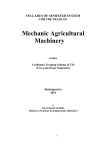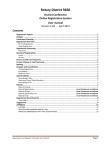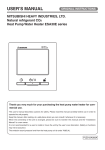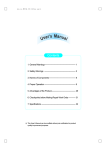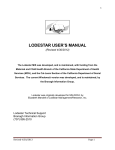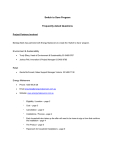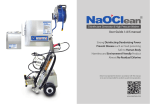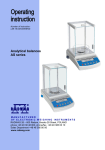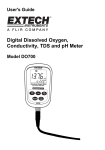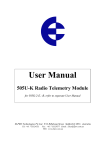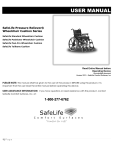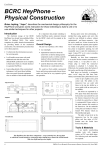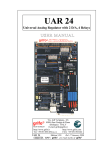Download Irving Art 01 leeaky Manual
Transcript
User Manual www.leeakyhose.com.au Index 1. The Advantages of Leeaky Hose . . . . . . . . . . . . . . . . . . . . . . . . . . . . . . . . . . . . . . . . . . 3 2. The Principles of Leeaky Hose . . . . . . . . . . . . . . . . . . . . . . . . . . . . . . . . . . . . . . . . . . . . 5 3. Applications/Uses of Leeaky Hose . . . . . . . . . . . . . . . . . . . . . . . . . . . . . . . . . . . . . . . . . 7 4. Most Common Asked Questions . . . . . . . . . . . . . . . . . . . . . . . . . . . . . . . . . . . . . . . . . . 8 5. Installation . . . . . . . . . . . . . . . . . . . . . . . . . . . . . . . . . . . . . . . . . . . . . . . . . . . . . . . . . . . . . 9 General Principles of Installation . . . . . . . . . . . . . . . . . . . . . . . . . . . . . . . . . . . . . . . . . . . . . . 9 Overhead Vs Underground Watering . . . . . . . . . . . . . . . . . . . . . . . . . . . . . . . . . . . . . . . . 9 Curing . . . . . . . . . . . . . . . . . . . . . . . . . . . . . . . . . . . . . . . . . . . . . . . . . . . . . . . . . . . . . . . 9 Flushing . . . . . . . . . . . . . . . . . . . . . . . . . . . . . . . . . . . . . . . . . . . . . . . . . . . . . . . . . . . . . .10 Soil Types . . . . . . . . . . . . . . . . . . . . . . . . . . . . . . . . . . . . . . . . . . . . . . . . . . . . . . . . . . . . .11 Spacing . . . . . . . . . . . . . . . . . . . . . . . . . . . . . . . . . . . . . . . . . . . . . . . . . . . . . . . . . . . . . . .11 Depth . . . . . . . . . . . . . . . . . . . . . . . . . . . . . . . . . . . . . . . . . . . . . . . . . . . . . . . . . . . . . . . .11 Soil Moisture Content . . . . . . . . . . . . . . . . . . . . . . . . . . . . . . . . . . . . . . . . . . . . . . . . . . .12 Watering Profile . . . . . . . . . . . . . . . . . . . . . . . . . . . . . . . . . . . . . . . . . . . . . . . . . . . . . . . .12 Setting Flow Rates . . . . . . . . . . . . . . . . . . . . . . . . . . . . . . . . . . . . . . . . . . . . . . . . . . . . . .12 Cycling . . . . . . . . . . . . . . . . . . . . . . . . . . . . . . . . . . . . . . . . . . . . . . . . . . . . . . . . . . . . . . .14 Installation (Flat land - Consistent Soil) . . . . . . . . . . . . . . . . . . . . . . . . . . . . . . . . . . . . . . . . .14 Above Ground Installation . . . . . . . . . . . . . . . . . . . . . . . . . . . . . . . . . . . . . . . . . . . . . . . .14 Below Ground Installation . . . . . . . . . . . . . . . . . . . . . . . . . . . . . . . . . . . . . . . . . . . . . . . .15 Installation on Slopes . . . . . . . . . . . . . . . . . . . . . . . . . . . . . . . . . . . . . . . . . . . . . . . . . . . . . . .16 Installation in Commercial Operations . . . . . . . . . . . . . . . . . . . . . . . . . . . . . . . . . . . . . . .18 Problem Solving . . . . . . . . . . . . . . . . . . . . . . . . . . . . . . . . . . . . . . . . . . . . . . . . . . . . . . .19 Typical Layouts . . . . . . . . . . . . . . . . . . . . . . . . . . . . . . . . . . . . . . . . . . . . . . . . . . . . . . . . .20 6. Water Supplies . . . . . . . . . . . . . . . . . . . . . . . . . . . . . . . . . . . . . . . . . . . . . . . . . . . . . . . . .21 High Pressure/Low head Compensation . . . . . . . . . . . . . . . . . . . . . . . . . . . . . . . . . . . . . .22 Low Pressure compensation . . . . . . . . . . . . . . . . . . . . . . . . . . . . . . . . . . . . . . . . . . . . . .22 Recycling Water/Grey Water . . . . . . . . . . . . . . . . . . . . . . . . . . . . . . . . . . . . . . . . . . . . . .23 Stored Rainwater . . . . . . . . . . . . . . . . . . . . . . . . . . . . . . . . . . . . . . . . . . . . . . . . . . . . . . .25 7. Aeration . . . . . . . . . . . . . . . . . . . . . . . . . . . . . . . . . . . . . . . . . . . . . . . . . . . . . . . . . . . . . . .26 Aquaculture . . . . . . . . . . . . . . . . . . . . . . . . . . . . . . . . . . . . . . . . . . . . . . . . . . . . . . . . . . .26 Oxygen transfer rates of Leeaky Hose . . . . . . . . . . . . . . . . . . . . . . . . . . . . . . . . . . . . . . .27 Aquaculture Case Notes . . . . . . . . . . . . . . . . . . . . . . . . . . . . . . . . . . . . . . . . . . . . . . . . .28 Sewerage Aeration . . . . . . . . . . . . . . . . . . . . . . . . . . . . . . . . . . . . . . . . . . . . . . . . . . . . . .29 8. Market Garden Configurations . . . . . . . . . . . . . . . . . . . . . . . . . . . . . . . . . . . . . . . . . . . .30 Waterways Farm Organics . . . . . . . . . . . . . . . . . . . . . . . . . . . . . . . . . . . . . . . . . . . . . . . .30 9. Leeaky Hose Vs Other Rubber based systems . . . . . . . . . . . . . . . . . . . . . . . . . . . . . .33 www.leeakyhose.com.au 1.The Advantages of Leeaky Hose 1.1 Summary Financial Benefits Saves 70% of water Reduces need for herbicides and weedicides Maximises fertiliser use Reduces pumping energy needs Will operate on low head Invisible system - less susceptible to vandalism Environmental Advantages Made from 100% recycled materials Allows use of “Recycled” water Reduces drain on finite water resources through reduced watering needs Can be used with dam, bore and river water Operational Advantages Fewer weeds Less plant disease (such as mildew) Significant savings in maintenance, support plumbing (No drippers or sprays to block) Easy to install and maintain Uniform water distribution Uses low cost standard fittings Ideal for awkward bed configurations Production Advantages Water delivered directly to roots Stronger root growth Less susceptibility to wilt No scorching or brown leaves Has a 5-year guarantee Can irrigate day or night without fear of burn Fewer weeds Reduced insect infestation www.leeakyhose.com.au 3 1.2 Why Install Leeaky Hose 1.2.1 Water Saving - Money Saving In the new ‘User Pays’ environment the cost of water is becoming a significant factor in household and business budgeting, though in most instances little can be done to make noticeable cost reductions. Leeaky Hose offers that opportunity to users who do use water outside the house. Considering that plants in a square metre of garden need on average 3 litres of water per day, and that it takes at least 10 litres from overhead watering to achieve it, saving two thirds of that water does offer an opportunity for savings. In most areas this process of water replacement (watering) takes place over the best part of five months each year. This, in turn, suggests that the average garden needs some 1500 litres per square metre each year. Currently in Melbourne, this would cost a mere $.0.97 cents in straight water charges per year, to which needs to be added a percentage of the arbitrary assessment for sewerage, which is a further 15 cents per kilolitre. But the average garden is generally larger than 1 sq. metre - in fact most are nearer 250 square metres (based on a quarter acre block). Multiplying $1.20 (water cost) x 250 (size of garden) = $300 per year to water the garden. Installation of Leeaky Hose can reduce this by two/thirds or more. These savings can be close to doubled if washing machine water or grey water are harnessed to Leeaky Hose (see the relevant section). For example, More than 1000 litres per week are used in the average household washing machine. 1.2.2 Other Benefits It is now well documented that below ground, or slow release, watering grows healthier and more drought resistant plants. As plants root deeper they pull more natural nutrients from the soil, thus reducing the need for added fertiliser. When compared with overhead watering methods, plants watered with Leeaky Hose are less susceptible to plant diseases, and there is a noticeable reduction in weed growth. With maintenance, Leeaky Hose requires less labour as it does not require supervision or adjustment, and is the ideal system for awkward bed sizes. www.leeakyhose.com.au 4 2.The Principles of Leeaky Hose Leeaky Hose has been designed to water or irrigate in the most efficient and beneficial manner yet known. i.e. to deliver water below the soil direct to plant root zones. Apart from the important water savings, this form of delivery achieves healthier, hardier and more productive plants. The Capillary Action of Soil. This principle of soil mechanics has been documented since the mid-18th Century.While soil mechanics can be quite intricate, the basic principal is that soil has the ability to draw water through itself by capillary action.The distance the water will travel from the source varies according to particle size.The larger the particle (e.g. sand) the shorter distance the soil can maintain mechanical tension.The smaller the particle (e.g. clay) the greater distance the mechanical tension is maintained - both horizontally and vertically. Microporous Delivery Systems Since the turn of the century various delivery systems have been developed and patented. Some of the most interesting were ones made from ceramics and another from canvas. Another one using rubber was patented nearly 30 years ago. As each of them had disadvantages or restrictions, none of them took the world by storm. All these relied on water pressure, and only the canvas one was able to be used in larger-scale agriculture. Pressure and Volume The higher the pressure through a given pipe diameter, the greater the turbulence (sometimes described as head loss), and the less distance the water will travel.The canvas hose overcame this by being tapered from 3” to 1/2”, but had problems in installation and tended to collapse once buried. And all hoses relying on pressure showed a tendency to become less efficient over time due to blocking from impurities. So the fact came to light that microporous walls carrying water at pressure are highly vulnerable to blocking by water impurities - so that despite intensive filtering of the water, they block up over time. The Leeaky Hose Breakthrough. The dry Australian continent, with its range of water sources from the totally pure, to turbid clay dams and iron bearing artesian water provided the challenge for a water-efficient delivery system which overcame the stumbling blocks that had inhibited the acceptance of earlier microporous systems. The goal was a microporous delivery system that could be used: · below ground for distances of at least 100 metres (110 yards), · was flexible and easy to install, and · was not susceptible to blocking by undissolved particles in the water The key proved to be the development of a NO Pressure system that was not inhibited by turbulence, and which did not drive solids into the pores. www.leeakyhose.com.au 5 How Leeaky Hose Works. Leeaky Hose is designed so that water can work through its walls, while it has no physical holes which would allow roots to enter. The porosity is controlled so that the water can ‘sweat’ through the walls at a controlled rate over long distances at low water pressure. At pressures of 4psi (25kpa) or below, the hose will deliver moisture to the surrounding soil through capillary action. This ensures that the system will deliver proper irrigation to plants even in extremely low pressure water reticulation areas, or from relatively low header tanks. When Leeaky Hose is turned off, the residual water is gradually taken up by the surrounding soil, so it is not attractive to plant roots or pests such as termites.The lack of physical holes also keeps the hose free of insect infestation. www.leeakyhose.com.au 6 3. Applications/Uses of Leeaky Hose 3.1 Watering/Irrigation for Domestic lawns and gardens Golf courses Horticulture Landscaping Market gardens Public gardens and reserves Orchards Ovals/playing fields Organic vegetables Vineyards 3.2 Aquaculture (Aeration/Oxygenation) Thermocline Prevention Aquariums Crustacean holding tanks Fish farms Prawn ponds Sewerage ponds Yabbie farms 3.3 Ground Stabilisation (maintaining minimum moisture content) Highway batter preservation Erosion control Prevention of foundation/slab cracking/shifting 3.4 Fertigation Delivering soluble fertiliser direct to plant root zones 3.5 Pest Control Sub-foundation delivery system for pesticides 3.6 Sewerage/Effluent Dispersal Hygienically acceptable dispersion of sewerage and grey water below the surface. www.leeakyhose.com.au 7 4. Most Common Questions About Leeaky Hose Why doesn’t it block with dam or bore water? Because it is a low pressure system and the dirt stays in the hose while the water passes through (See Section 1 and 5.1.3) How long will it last below ground? It is made of non-volatile and non-reactive materials. Leeaky Hose is guaranteed for five years. The limits of its life have yet to be determined. Does it need to be buried? No. But if used on the surface it must be covered (See Installation). It does operate most efficiently when all of it’s wall is in contact with the soil. How far can it go in a single run? Approximately 120 metres below ground and 60 metres above. (See Installation) Is it poisonous? No. It is made from recycled tyres and food quality polymers. Recycled rubber is used in children’s playgrounds and often as plant mulch.There is NO cadmium in car tyres. Can you install it on slopes? Yes, but this requires different installation procedures (See Installation-Slopes) Why is it better for fish pond aeration? The finer bubbles provide 5 times greater oxygen transfer for a given amount of air, and lower pressure means lower energy costs. In the correct pattern, LH can also replace water circulation mechanisms (See Aquaculture). How far does water travel through the soil? This depends on soil type, but up to a metre either side in fine clay, and 1/2 M in sand. Why don’t roots get in? There are no physical holes in LH, also water does not stay in the hose to attract roots. Why don’t insects get in? There are no physical holes for them to enter, and as long as it is kept sealed at each water entry poiny insects cannot enter. Is it termite proof? Testing by CSIRO has shown that the two most common Australian termite species show no interest in LH. Is it susceptible to sub-zero temperatures? Leeaky Hose installed in the Aust. Alps three years ago is still functioning though other normal hose and other piping has cracked and has had to be replaced. www.leeakyhose.com.au 8 5. Installation 5.1 General Principles of Installation 5.1.1 Overhead Vs Below Ground Watering Heavy surface watering is generally bad irrigation. Above ground watering (& flood irrigation) has a tendency to encourage shallow root systems, which in turn, are quickly affected by hot temperatures and dry winds, which leach water from the top few centimetres of soil. Heavy surface watering also can force the finer soil particles in the soil to migrate downwards, reducing surface soil density and forming a denser layer that slows down the movement of air and water from the surface (panning). One of the most telling arguments is that water penetration from above ground is a lot slower than the below ground capillary action. Even in ideal soils, water penetrates at the rate of 1cm per hour. So the effects of 2 hours of above ground watering in the evening can be sucked from the soil by hot winds the following day. 5.1.2 Curing (The following information relates to Leeaky Hose manufactured before March 1998. Hose manufactured after this date does not require curing) Leeaky Hose is supplied in an uncured state, and leaks initially at a rate exceeding 18 litres/metre/hour (l/m/h). Over the first 24 hours of use the rubber composite cures and the porosity drops to around the normal leak rate of 2 l/m/h.This is normal. In fact, this curing takes place over a period of weeks, but 99% of the curing occurs in the first 24 hours.To cure hose intended to be used on very low pressure it is important to cure the hose at a higher pressure. To do this, (using the rate per minute formula), put your hose length into the formula and adjust your tap to a flow rate of approximately twice the value calculated. For example, if you calculated either from the formula, or the table, that you needed 1 litre of water per minute, adjust your tap to two litres per minute. Run your hose for 12 - 24 hours (the longer the better). Do not apply full town pressure. If you see little spurts, then the pressure is too high for the length you intend to run and the hose will be damaged. This sets the porosity so that it will run on a low head or low pressure.This only needs to be done the first time you put water in the hose, and it is not necessary if using a high pressure as your normal supply, or a short run.With very low pressure we recommend having the hose in as much contact with the soil as possible (i.e. buried).The water tension in the soil is a very important factor when operating on these low pressures. Generally the finer the soil the greater the water tension. www.leeakyhose.com.au 9 At the start of the curing process it will be noticed that the hose leaks only at one end (or the middle). Gradually the leaking will extend to the full length of the hose. This is a part of the curing process. Also the time period of this process can vary depending on length of run, slope, or how long the hose has been coiled in a roll.This is the hose regaining its original ‘memory’. Important:With too high a flow rate with dirty water, water-borne solids could be driven into the wall cells of Leeaky Hose - gradually and permanently reducing its effectiveness. 5.1.3 Flushing Allowance for flushing is an important part of a Leeaky Hose installation. In the normal operation of the hose any particles will be left behind on the floor of the hose as the water passes through the walls. An installation should either have a back-flush system (particularly if the hose is deeply buried), or the end plug clearly marked so that it can be accessed and removed for flushing. Regularity of flushing.There are no hard and fast rules, though it should be part of any preventative maintenance programme to flush every six months.The visibility of particles is not always a guide to particle density and flushing should be the first procedure carried out should any drop in the flow rate be noticed. Note: any drop off in water flow rates will be gradual. How to Flush - No special water supply is needed. After removal of the end plug/s, or opening the flush valve, the water would be run at 50% greater flow rate for an hour, or until the discharged water is seen to run ‘clean’. www.leeakyhose.com.au 10 5.1.4 Soil Types While there are three main soil types - sand, loam, clay - the porosity of a soil can vary quite markedly in one plot of ground.The understanding of soil type and its characteristics is important when designing or installing a Leeaky Hose system, as it relies totally on the soil’s inherent water transfer characteristics.Water travels more slowly, but further, in fine soils like clay. It travels faster in sand, but only half as far. In recently cultivated, or heavily mulched soils, there may not be sufficient particle contact for water to travel laterally - no matter what the original soil type.This sometimes is the cause of ‘dry’ spots. A variation of soil type down a run of Leeaky Hose also could result in ‘wet’ spots where a patch of finegrained soil is taking up water more slowly than the surrounding soil.Where found this patch should be isolated by a separate tap or feed line if possible. One solution would be to reduce the flow to adjacent ‘wet’ spots by installing an In-line tap between the two sections and to reduce the flow rate to the coarser soil. 5.1.5 Spacing To work out the optimum spacing for Leeaky Hose it is recommended that the hose be placed on the ground during an initial 12-24 hour curing period.Then the spread of the water through the adjacent soil can be measured by digging down into the soil at varying distances (more deeply the further from the hose).This will suggest the optimum between each row of hose. These first results will show the minimum spacing, as the water tends to travel further once the soil has been ‘conditioned’ by several cycles and soil moisture content is brought up to minimum levels (see 5.1.7) The following table gives a general indication of spacing: Soil Type Spacing Sand . . .1.0 metres Loam . . .1.6 metres Clay . . . .2.0 metres For Lawns & Ground cover: Halve these spacings. 5.1.6 Depth Leeaky Hose can be placed from 1 - 30cm below ground in heavy soils, but should not be placed below 15cm in coarse sands.Water will travel vertically above the hose (See 5.1.8) as long as it is charged for a sufficient period of time. Initially, conventional overhead watering may be needed to assist seedlings and lawns to become established. www.leeakyhose.com.au 11 5.1.7 Soil Moisture Content While capillary action works in all soils it has an essential pre-requisite. It will only work when the background soil moisture content is greater than 43%. If the ground is drier than this - and this is often true in ground that has only been overhead watered previously - capillary action will not work immediately. If the hose is buried, this will show as wet spots on the surface of the trench area. There is only one solution - to turn the hose on every 48 hours until the minimum moisture level is restored.This will need to be repeated until the background moisture levels have reached the 43% mark, and the spread of water is within the parameters for the soil type outlined in 5.1.4.The length of this process is purely a factor of how dry the soil was originally and whether or not it is a fine or coarse particle type. 5.1.8 Watering Profile The sub-surface water profile from a length of Leeaky Hose (or any other slow-release system) also varies with soil type.This, and the needs of the existing or intended plant should be taken into account in an irrigation situation. In clay the water cross-section has a profile similar to a field mushroom, with the outer edges a metre from the hose only centimetres below the highest point. In loam it assumes a more ‘button’ mushroom profile. In coarse sand the profile is shaped like a ‘teardrop’ with the outer edges half a metre from the hose being some 15cm from the drops highest point.This will not matter for trees and established shrubs whose roots will quickly find the water, but it must be taken into account in situations like lawns or ground cover. 5.1.9 Setting Flow Rates DO NOT apply high pressure directly to Leeaky Hose, as this could damage it. If you see a lot of little spurters, the pressure is too high. Leeaky Hose is a slow soaker system and is not designed for high flow rates. Leeaky Hose may be used if you have a high pressure water supply, however you will need to regulate the flow of water running into the Leeaky Hose by means of pressure reducing valve before an in-line tap set to no more than 75kPa (10.5psi – 25’ head). If using an in-line tap you need to do the following calculations in order to set the flow rate: The nominal rate of leakage is 2 litres per metre per hour. If, for example, you are running a 30 metre length of Leeaky Hose, the amount of water required to be delivered to the soil in an hour over the length of the hose would be 60 litres. Divide the total volume (in this case 60 litres) by 60 (to get therate per minute).This gives you a flow rate of 1 litre per minute. Now run water through the in-line tap where it is to join the hose and adjust the flow rate until a 1 litre container is filled in 1 minute.The position of the in-line tap is now set, and can be left connected with the hose.This only needs to be approximate. www.leeakyhose.com.au 12 Now run water through the in-line tap where it is to join the hose and adjust the flow rate until a 1 litre container is filled in 1 minute.The position of the in-line tap is now set, and can be left connected with the hose.This only needs to be approximate. The formula would read as follows: hose length x 2 litres/minute = rate per minute 60 LH Total Length Litres per Hour Millilitres per Minute 10M 20 300 15M 30 500 20M 40 700 50M 100 1600 (1.6 litres) Caution: Notwithstanding the above calculations, as stated elsewhere, there is a finite amount of water that can be carried by Leeaky Hose. If after setting the flow rates to the above calculation you notice that the hose is spurting or spraying in its early sections and starving at the other end, then you areputting too much water into it. Reduce the flow until the spurts cease and the hose begins to leak uniformly. www.leeakyhose.com.au 13 5.1.10 Cycling If Leeaky Hose is turned on all the time your plants will DIE. Now we have your attention, it is important to understand that many of the ancillary benefits of Leeaky Hose come as a result of proper ‘cycling’ of the system. Each time Leeaky Hose is turned on for the proper period it lifts soil moisture content up to the high 90% levels.When this is achieved, the Hose should be turned off. Over the ensuing three or more days this water level will gradually reduce, encouraging plants to root more deeply as they follow it down (also picking up more nutrients from the soil as they go). At no time should water levels be kept this high as eventually your plants will get ‘wet feet’ and suffer the consequences of this. How often to cycle? The unsatisfactory - but honest - answer is that this depends on some four or five factors. But a rough guide is to water at least once a week and for at least six hours (unless watering in coarse sand at the higher rate). Rainy Season watering? Unless you are totally sure that your ground is water-logged you should stillwater in the rainy season, if only to be sure that your sub-soil moisture content does not fall below the 43% required to maintain capillary action. Another good reason is to continue encouraging your plants to keep rooting deeply and thus to become ‘shockproof’ faster. It is handy to remember that it takes an hour of overhead watering to penetrate 1cm of soil, so that even an hour’s heavy rainfall will not by itself put any water into your plant’s sub-surface root zones. 5.2 Installation (Flat Land - consistent soil) 5.2.1 Above Ground Installation When planning your installation take special note of any plants with heavy water needs, or high points over which the hose may travel.These will need to be compensated for in your plan. High Points. In runs under 20m in length, these should not be a problem. In longer runs the Leeaky Hose should be run to either side and linked across the high point with non-porous poly pipe or hose. High Consumption plants. In many cases these can be compensated for by running an extra length (or circuit) of Leeaky Hose in the root zone to deliver the extra water needed during the same watering cycle set for your less thirsty plants. If this is not sufficient the plant will require a separate feed and extra watering cycles. Length Constraints. Without surrounding soil and its subsequent hydrostatic pressure, the maximumcontinuous run of Leeaky Hose above ground from a single feed is 60 metres unless fed in the middle or from both ends. It should also be noted that the longer the run, the lower the flow rate per metre per hour.This is a factor of the physical amount of water that can be passed through a 13mm hose at low pressure in a given period. In some situations this can be as low as 1/2 Litre per Metre per hour.This translates into 1/4 Litre per square metre on either side of the hose.This will be insufficient for some applications, or require impractically long watering cycles. By feeding from both ends the flow rate will be more than doubled. www.leeakyhose.com.au 14 Installation Steps 1. Plan your watering system (see above). 2. Lay out the hose where required. 3. Connect to water source and turn on tap to ensure that water flows freely through the hose.Then insert end cap or other stopping device. 4. Set flow rate for ‘curing’ (at least 4L/m/h) - See 5.1.2. use method described in 5.1.6. 5. When comfortable that hose is cured and flowing evenly it must be covered with mulch or soil. 6. Check after cycling several times to ensure that the watering profile is within the capillary bandwidth. If it is not, continue the cycling process. (See Cycling 5.1.7) 5.2.2 Below Ground Installation The advantages of installing below ground include: · Greater achievable flow rates on medium runs · Longer single runs (up to 120 metres from a single water source) · Even greater water savings · Lower susceptibility to ‘crusting’ of dissolved minerals from the water · Less surface weed germination · Ability to fertilise underground The installation steps are similar to those for above ground. Set trench depth according to soil type and plant needs. If plants are naturally shallow rooted keep the depth to around 10cm. Keep trench relatively level without sharp bumps or dips. Installation Steps 1. Follow Steps 1 - 4 above. 2. When water flow through hose is established and it is clear that there is no blockage, the hose may be covered. 3. After completing the first watering cycle, check water spread by digging into the soil at varying distances. If only the trench area is wet the surrounding soil is too dry to support capillary action,and the hose will need to be cycled until the soil has been conditioned. 4. Accidental Damage. If the hose is subsequently damaged when tilling the soil, this will show by a pronounced wet spot on the surface.To repair, dig down to the hole, cut across the hole and insert a 13mm barb joiner. www.leeakyhose.com.au 15 5.3 Installion on Slopes 5.3.1 Across Slopes. Leeaky Hose works best across slopes. Leeaky Hose is, in fact, a preferred product for preventing erosion on steep slopes. To equalise the flow from a single header to multiple runs of Leeaky Hose there are several proven methods. The first method (for gentler slopes is to place a run of polypipe down-slope and “T” off to Leeaky Hose so that it runs across the slope This can be achieved by running normal hose or poly pipe down the slope and running Leeaky hose from it. Method A The in-line taps are placed in the feeder line at approximately each metre of fall and the flow rate adjusted to the appropriate water requirement for the number of metres of Leeaky Hose below each tap. Method B The following method offers the advantages of irrigating larger areas from a single feed line (as it can be run at pressure), and reduce or increase water flow rates for isolated patches of different grained soil. In the above diagram the single in-line tap feeding each three or more lines of Leeaky Hose is fed from a high-pressure line.The flow rates through each tap can be regulated for the individual soil type or plant needs. www.leeakyhose.com.au 16 5.3.2. Down Slope Leeaky Hose can run down slopes more than 2.5 degrees, but a pressure reducer or in-line tap is required every metre of fall so that the lowest runs of LH do not receive all of the water. The first (preferred for gentler slopes - less than 10 degrees.) and simplest method is to work up from the bottom of a run. As Leeaky Hose is not a pressure system, but a water delivery system, the flow of water needs to be regulated to some degree so that each section receives roughly the same amount of water in a given time period. In-line taps can be used to regulate the flow to each section. In the above example, in-line tap ‘C’ is inserted in the hose on the first metre of fall up the slope and the flow rate is adjusted at (for example) 2 litres (L) per metres (M) per hour where (M) equals the number of metres between ‘C’ and the end of the hose.Tap ‘B’ is adjusted for the flow rate required between B and C PLUS the flow rate from C downwards.Therefore tap ‘A’ would be set for the flow rates required from the start to ‘A’, plus the flow rates required through ‘B’ and ‘C’. www.leeakyhose.com.au 17 5.4 Installation in Commercial Operations 5.4.1 Soil Preparation. The following method is a general rule, but is essential for highly compacted clays and heavy loams. It is also essential if the soil is to be planted within a month of installation and water or time is not available for soil conditioning (i.e. bringing soil moisture levels up to where capillary action can occur). Soil must be ripped to the depth to which the plants tap roots can be expected to grow. This can be us much as 40cm for tomatoes, corn and sunflowers. Where Leeaky Hose has been laid in the centre of a bed that has only been superficially tilled, plant tap roots will grow vertically until the hard pan, then horizontally towards the centre water source, halving the water available to their inside neighbour. 5.4.2 For Optimum Installation 1. Unroll the hose along side the target bed without dragging.Then whip and shake until the hose lies flat and shipping coils are released. 2. Connect water at feed end at 6 -10 litres per hour leaving other end open until the full length waters evenly. 2.1 Uneven Watering. If sections are not watering evenly leave water flowing and clamp off flow after the first tight section nearest the feed end and leave for 1 - 2 hours or until flow from section matches rest of section. Do this for each ‘tight’ section until full length waters evenly. 3. With water still flowing, lay hose without kinks into pre-prepared trench 30 - 40cm below surface. 4. Check open end to see that water is still flowing at pre-installation rate. If flow is reduced, check for kinks.When flow rate is satisfactory, plug end and fill trench. 5. Leave hose flowing for 2 - 4 hours at a time with 2 - 4 hour intervals (or until surface wet spots occur), to bring sub-soil water content up over the 43% level. (This can be verified by digging a spade depth down at the estimated spread level for the type of soil. i.e. 1 metre from trench on clay). www.leeakyhose.com.au 18 5.4.3 Problem Solving Causes of severe over-watering of first 2 - 5 metres · Excessive flow above 4 l/m/h · Hose laid at lesser depth and too close to feed end of bed · Feeder hose is lower than the Leeaky Hose it is feeding. · Over-porous section of Leeaky Hose. 5.4.4 Feed End Flow Field trials show that in long runs (80 - 120 metres) Leeaky Hose feeds best with rural water where the feed hose is looped prior to connection to the Leeaky Hose and the In-line flow regulating tap installed at the top of the loop. In-line Tap Water Source www.leeakyhose.com.au 19 5.5 Typical Layouts www.leeakyhose.com.au 20 6.Water Supplies In the main the quality of the water going into the hose is irrelevant to the performance of the hose for irrigation purposes, providing that it is not put in at pressure.The only major criterion is that anything dissolved in the water is not harmful to the plants for which it is intended. 6.1 Water Solids 6.1.1 Water Calcium In South Australia much of the underground water, especially in the South-east, has high concentrations of calcium.These concentrations are high enough to cause problems with micro sprays and drippers - sealing them on a regular basis. Most commercial growers and vineyards spend a lot of money on complicated filter systems to reduce the regularity of the blocking, and home gardeners replace components on a regular basis. Calcium carbonate has low solubility in water and begins to precipitate from water droplets which have a relatively large surface area, immediately upon being exposed to the ambient air. Therefore scale deposits begin to form immediately above-ground systems are activated. Leeaky Hose has been installed below ground in this area of South Australia for two years and systems have not been affected by the calcium. This is believed to be for the following reasons:· When installed below ground it remains moist between watering. It is also not exposed to · · high ambient temperatures and air flow which would cause the calcium and lime to form a crust. Drippers and sprays have only one or two small outlets which flow at around 2 litres per hour. Leeaky Hose’s flow rate is slower as two litres per metre per hour is released each hour through thousands of pores in each metre.Thus the calcium is applied over a much greater surface area. With each water cycle through Leeaky Hose the pores firstly expel air as the hose is charged, and the hose swells.These actions effectively contribute to removing any scale that may have built up. 6.1.2 Filters If using pressures higher than 25kPa (4psi), you MUST use a filter.This is because at pressures greater than this, the dirt particles are driven into the pores and may not be easily removed by flushing.This also applies to the inline tap method of pressure control. www.leeakyhose.com.au 21 I6.2 High Pressure Compensation Alternative System for High Pressure or Pumped Water Supply Break the pressure by using a ball cock in a tank.The tank is elevated to provide the pressure, whilst the ball cock keeps the tank topped up.The advantage of this system is that it is easier to monitor the amount of water applied if you turn off the incoming water once the tank is full. It is also very easy to apply liquid feed. No atmospheric losses are experienced as the nutrients are delivered directly to the root zone. 6.3 Low Pressure (Low Head) Compensation If your Leeaky Hose is a long way from the source (more than 20 metres), or if the water volume delivery to the beginning of the Leeaky Hose is below the required rate, a larger diameter feeder hose will compensate in most cases. We recommend thin-walled polypipe in either 16mm or 19mm diameter. Doubling the diameter of the feeder hose increases the cross-sectional area by four times, so a small increase in diameter gives a lot more volume and enables much longer supply lines. Reducing joiners and ‘T’s are readily available to connect the feeder hose to 13mm so it matches Leeaky Hose. Useful Conversion Factors 1.0 metre of elevation = 10kPa = 1.45psi 7.5 metre of elevation = 75kPa = 10.5psi 1.0 litre = 1000 millilitres 1.0 metre = 3 feet and 3 inches www.leeakyhose.com.au 22 6.4 Water Timers on Low Pressure If you are planning to use a timer with low pressure irrigation, check with the supplier that the solenoid valve used to shut off the water will operate on low pressure. Many solenoid valves are designed in such a way that the incoming pressure assists the valve to close. As strange as it may sound, a valve of this type may not shut off a low pressure supply, so in effect it will be useless. To get around the problem you can put a solenoid on the high pressure side of the pressure reducing valve or regulating tap, so there is effectively high pressure on each side of the valve. The reducer or In-line valve can be preset to the desired low flow rate for Leeaky Hose. If using a tank, you will have to find a valve that operates on low pressure. 6.5 Recycling Water (Grey-Water) 6.5.1 Introduction Regular users of Leeaky Hose know the enormous savings that can be achieved, but where water supplies are limited, or expensive, and for some people who are on very restricted water supplies, no amount of water saving is enough.There is however a solution. 6.5.2 Grey water - there is lots of it Every time you do a load of washing up to 180 litres of water is used and this normally goes to waste. One wash a day adds up to 1260 litres of water a week. Everyone has this waste water, so if this could be utilised efficiently, it would solve every gardener’s problem of keeping their garden flourishing during the dry months.To this can be added the five litres per minute spent by each person in the shower each week. Leeaky Hose has been on trial in New South Wales and New Zealand with grey water to make sure it would operate as a low maintenance system and that it would not block with lint. A small capital investment is required, depending on where your laundry is situated and what you have lying around, but if you compare this to the cost of buying water, the system cost is minimal. 6.3.3 The system The only real problem we have with grey water is lint, and there is lots of it. If you don’t want your clothes to wear out, then don’t wash them. Lint will not block Leeaky Hose permanently, but it is a nuisance having to flush the hose regularly and can sometimes effect the ability to place it in a permanent location.To avoid this, we must let the water settle for 24 hours, and then take the water off at approx. 100cm from the bottom. After settling, the water needs to be put through a 200 mesh filter to get rid of the remaining lint. If you are fortunate to have your laundry elevated then you can use gravity feed to your hose. But if your machine is on the ground floor then you will need a small pump to push the water into an elevated holding tank. Once in the holding tank you can gravity feed your garden. www.leeakyhose.com.au 23 Grey Water Schematic It pays to have two settling tanks (2 x 200 litre drums), so the washing machine hose can be alternated each day from tank to tank. Lint can be drained from the bottom of the settling tanks. Every now and then put some fresh water through the hose to flush out any soap residues. Washing water does not normally harm plants, grass for instance thrives on it. However some plants may be sensitive to grey water, so it is advisable to test the plant , or if in doubt, keep the water away from it. Pump: The pump and collection tank can be quite simple and inexpensive. One 20 litre tank placed in an appropriate place under or near the laundry to take the flow from the washing machine. Into this can be placed an inexpensive bilge pump (as used in boats) to pump into storage tanks. If placed beneath the house ensure that there is appropriate drainage for the overflow. NOTE: Council permission may be required in some areas for grey water recycling. As every situation is different variations on the layout will be necessary, the above diagram is a guide. www.leeakyhose.com.au 24 6.6 Stored Rainwater Rainwater can be collected from the roof of your house, shed or glasshouse and stored in an elevated tank. Did you know that 10mm of rain on 1 square metre of your roof produces 10 litres of water (2.19 UK gallons)? Even a small shower during the summer period could provide useful water for your garden. www.leeakyhose.com.au 25 7. Aeration 7.1 Aquaculture Using Leeaky Hose as an air carrier in fish ponds increases profits through faster growing fish, less food waste, and shortened harvest intervals. 7.1.1 Why Aerate For Aquaculture? 1. Grow more fish in a given area of water. 2. Grow fish faster through increased food supply. 3. Reduce losses of fish through stratification. 4. Lower food costs per kilo of fish harvested. 7.1.2 1. 2. 3. 4. Leeaky Hose Aeration Increases oxygen levels in any given area of water Provides greater levels of oxygen to phyloplankton (food) Equalising water temperature through continual convection More food through faster, more efficient breakdown of pond waste. Before the development of Leeaky Hose, fish, eel and lobster growers had two options. 1. To let the fish grow naturally (and very slowly with marginal profits), or 2. Install paddle wheels, aerators and carry power to each site. The second course of action was available only to major growers able to make the capital investment and pay the continuous energy costs without any return on their investment for three or four years. Leeaky Hose aeration is not only 70% - 80% cheaper to establish, but is 500% more efficient in adding dissolved oxygen to the water. Leeaky Hose installations typically require 50% less in annual energy costs. Those farms which introduce some form of aeration will increase pond yields because of: 1. The low cost of Leeaky Hose (compared with paddle wheels), 2. Not having to run expensive electricity lines to each dam, and 3 .The higher dissolved oxygen yield for a given volume of air. 7.1.3 Why Is Oxygen So Important in Water? When we put fish into a pond, we put them there to grow, not to practice their survival skills. But in still water the oxygen that is used is only replaced slowly, through oxygen brought in during rain falls, or wave action on the surface on windy days. In the meantime the fish are competing for the oxygen with the phyloplankton and the bacteria that break down the pond waste into food. If the fish use the oxygen they will not grow bigger because their food supply is low. If there is not sufficient oxygen for the aerobic bacteria to grow, this makes it possible for anaerobic bacteria to flourish. www.leeakyhose.com.au 26 7.1.4 Oxygen Transfer Rates with Leeaky Hose Testing carried out by the United States Department of the Interior, Fish and Wildlife Service against air stones gave the following results: Porous Hose 1 air stone 4 air stones Surface Area 0.098 sq. M 0.23 sq.M. 0.97 sq. m. Actual Air Flow 3.76 litres/minute 3.76 litres/minute 3.76 litres/min Air flow corrected 5.009 5.458 5.989 Standard oxygen Transfer rate 223.7mg/min 91.02mg/min 135.4 mg/min Efficiency 16.11% 6.0% 8.2% i.e. To bring a pond 40 metres by 80 metres x 2 metres deep from 0% oxygen content to saturation @ 20 ºC requires the hose to be run at 2.66 p.s.i. for 12 hours. If the water temperature is lower the hose will need to run longer to achieve the saturation. This entails a configuration of 90 x 10m lengths, ideally spaced at approximately 4 metre spacings. 7. 1.5 Airflow Rates Vs Back pressure Airflow testing of 20 metres of Leeaky Hose at a depth of 1 metre demonstrated its ability to cope with and supply from 20 cu. ft./per minute/ to 300 cu.ft. per minute. At the lower rates this delivered 33 cu. Metres per hour per metre length of LH.\ As the length of the runs increase the tyranny of the Reynolds Number in relation to turbulence will come into play. Back Pressure. On start-up there is significant back pressure as the air drives water from the hose.The answer to this is to start-up gradually and take 3 - 4 minutes to lift your flow rates to the desired level. www.leeakyhose.com.au 27 AQUACULTURE - CASENOTES Supplied by Bruce Wells Secretary Australian Freshwater Crayfish Society Dondingalong, via Kempsey, NSW Bruce Wells has been using Leeaky Hose and the Iceland AirWick product for four years. He currently has three 1.8 metre deep ponds in production with Tropical Redclaw and Southern Blue claw crayfish. It is driven by a 1.5kWh pump at a pressure of 49kPa feeding through 13mm poly pipe to the run at the bottom of the ponds. He says that by changing the pulley on the pump it will deliver sufficient volume to aerate a fourth pond. He currently runs the pump for about 10 hours each night. The Leeaky Hose is installed through house bricks keeping it some 15cm off the mud, which allows the crayfish sufficient clearance to walk under. Benefits of Leeaky Hose 1. Capital outlay. By using Leeaky Hose to aerate and circulate the water he has dispensed with the need to run electrical power to the ponds to run paddle wheels or other devices, which normally require 3-phase power. 2. Water circulation.While concise rates of circulation have not been recorded, Bruce says the circulation can be proved by the lack of variation in water temperature. "In Spring and Autumn we can have 25° days and a frost at night.With paddle wheels or no circulation this would leave us with water surface temperature of 14° while the bottom temperature was 4°C. "By running Leeaky Hose overnight there is 0.5° or less difference, and a water temperature of around 10°C." 3. Stocking levels. Bruce believes the improved aeration allows pond stocking to be doubled. 4. Algae. Algae is not a problem as his water is turbid (cloudy). He takes the sign of any algae growing as a sign that he is over-feeding. Overfeeding will also deplete oxygen as it is absorbed by the decomposing food. www.leeakyhose.com.au 28 7.2 Sewerage Aeration The efficiency of Leeaky Hose for aeration of fish ponds is equally relevant to the oxygenation of sewerage ponds. In most applications it will not only provide superior aeration for the same air flows, but will require less energy to achieve. Also as it is not subject to corrosion, the longevity of LH is believed to be greatly superior to stainless steel pipes and membranes and most water lifting devices. Installation In most ponds the preferred installation method would consist of fastening Leeaky Hose in a spiral to a steel or plastic grid raised to a minimum of 20cm above the floor of the pond. A number of smaller grids would be preferred to the installation of a single large grid to allow redundancy and greater ease of handling. 7.3 Maintenance While Leeaky Hose is not susceptible to blocking from the air flow, it can be prone to build-up of fungus on the outer wall. If this is not dealt with on a regular basis, the fungus will gradually grow into the wall cells. This can be done by removing it from the water every 3 – 6 months and soaking in a chlorine solution, or passing a chlorine solution through it every three months. www.leeakyhose.com.au 29 8. Market Gardening Configurations Leeaky Hose is superior to overhead watering for plants that are susceptible to mould and fungus diseases from overhead watering. Leeaky Hose can be installed in a range of configurations according to the farm layout, and particular vegetable types. In a number of cases the hose is laid just below the surface before seedling plantings, then recovered after harvest. Depending on the length of the bed or the run of Leeaky Hose, an additional run of Leeaky Hose is often laid during the heading of vegetables such as lettuce and cabbages to ensure sufficient water is available during this phase. Following is a report from Waterways Farm, in the Barossa Ranges of South Australia, which has established organic farming status. Waterways Farm Organics Eden Valley Road, Keyneton South Australia 5353 Contact Bernie Smith: (015) 186 710 Waterways Farm is located at Evandale, Kyneton. One of the first farms settled in the Barossa Ranges of South Australia, the farm orggamically produces vegetables, fruits, herbs, flowers, timber, seedlings, seeds, honey, compost, medium merino wool, mutton and poultry. The farm is gently undulating at 400 - 450 metres altitude, experiencing a typical Mediterranean climate with 400 - 600mm annual rainfall.The low rainfall is insufficient to allow intensive market gardening using traditional overhead watering methods. Soils range from sandy loam to clay loam. European farming methods had destroyed soil structure, depleted organic matter and added toxic substances. In 1993 after serious drought and loss of topsoil, alternative farming methods were actively sought and Leeaky Hose was first trialled in that year in the vegetable garden. Since that time the vegetable operation has been expanded to six acres, consisting of a series of formed beds either 60 or 120 metres long. www.leeakyhose.com.au 30 Water Use The 1993 trial proved we have been able to reduce water usage by 75 - 80%.The majority of the formed beds have a single run of Leeaky Hose in the centre of each 1.5 metre wide bed, placed just below the surface, or on the surface and covered with mulch before the seedlings are planted. The seedlings are raised in Arborcell units, which guarantees that each has a long, untangled root structure of up to 10cm long before transplanting into the beds.This ensures that the seedlings are able to immediately secure moisture from the pre-wetted beds, drastically reducing losses. Once the plants are established the watering cycle is slightly reduced to ensure that the surface remains dry and the taps are regulated to ensure that the lines supply at a maximum of 2 litres per metre per hour. Watering Supervision Leeaky Hose has given us considerable time savings over all other systems.Watering flexibility is much greater with Leeaky Hose, as plants are generally deeper rooted. Constant checking of emitters has been eliminated.The larger wetted soil volume has led to longer intervals between watering cycles. Plumbing Infrastructure The low operating pressure of Leeaky Hose system means quick and easy installation, and the ability to gravity feed without the need for pressure pumps.The system uses standard fittings. Inline taps are used at the start of each row to adjust flow rates in undulating installations and for individual vegetable types.These factors have led to significant savings in support plumbing, pumping and maintenance costs. A 2” (50mm) main covers the first 800 metres from the dam and is connected to 19mm feeder lines that are led across the beginning of each bed. A 13mm is tapped into the feeder line for each bed and connected via an in-line tap directly to the Leeaky Hose. Fertilisation Liquid fertiliser may be applied through Leeaky Hose. No atmospheric losses are experienced as the nutrients are delivered direct to the root zone. With each watering sequence atmospheric nitrogen is pumped through the soil, assisting general aeration and encouraging worm activity. Diseases, Pests and Weeds These problems have been virtually eliminated.The surface of the soil remains relatively dry preventing the breeding of diseases, insects and weeds.This has been particularly noticeable on snow peas. Conventionally watered (sprinkler) snow peas have shown a strong tendency to contract downy mildew, Leeaky Hose watered snow peas have remained free of this disease. Generally, disease, insect and weed problems have been reduced by 70% or more. www.leeakyhose.com.au 31 Species Segregation and Companion Planting Conventional watering systems make companion planting or inter cropping difficult due to conflicting water requirements. Leeaky Hose has enabled us to practice companion planting with ease and subsequent success. Planting and harvesting can be carried out with much greater flexibility.This factor has enabled us to produce seed as well as fresh produce. Root Growth and Yield A much larger volume of soil in each bed has been accessed by the plants for nutrients. The deeper rooted growth has led to less stress on very hot days.Yields have generally been 20% higher. www.leeakyhose.com.au 32 This document is copyright and all rights reserved by Premier Plastics P/L 65 - 67 Killara Road Campbellfield Victoria 3061 Australia T + 61 3 9357 8477 F + 61 3 9357 8938 www.leeakyhose.com.au [email protected] www.leeakyhose.com.au 33


































